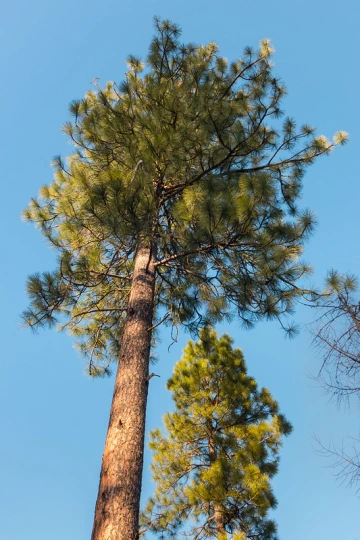
Ed Suominen Flickr.com
Botanical Family: Pinaceae
Scientific Name: Pinus ponderosa
Common Names: Ponderosa pine, pinabete, bull pine, western yellow pine, blackjack pine, rock pine
Botanical Description:
Pinus ponderosa is a magnificent conifer that commonly reaches over 150 feet tall and 30 feet wide, with rare specimens exceeding 250 feet tall and hundreds of years in age (1, 2, 3). The habit of young trees is pyramidal, while mature Ponderosa pines lose branches and develop an open, irregularly conical crown (1, 4). The large, straight trunk possesses black to dark-reddish bark when young, and characteristically orange to russet bark when mature (2, 4). The branches are also orange-brown in color, but darken with age, and house 3 yellowish-green needles per fascicle (5, 6). Male strobili are red, while female strobili are yellow, and will develop into scaley brown cones with slender prickles (4, 6). The cones house 2 triangular, winged seeds per cone scale, up to an inch in length (4).
Ecological Significance:
Ponderosa pine is an extremely important species to southwestern forests, providing habitat for numerous wildlife and insect species, while assisting in fire resistance and restoration (3, 7). Ponderosa hosts 23 confirmed and 83 probable species of butterflies and moths, including Chiricahua white (Neophasia terlootii), Pandora pinemoth (Coloradia pandora), and pine white (Neophasia menapia) (1). Dependent birds include red-winged blackbirds, chickadees, mourning doves, finches, evening grosbeak, jays, Clark’s nutcracker, nuthatches, rufous-sided towhee, turkeys, and grouse (8). The seeds are consumed by countless wildlife, such as chipmunks, squirrels, and mice, while growth is browsed upon by porcupines, mule deer, and elk (2). Additionally, as an important species in evergreen forests, Ponderosa pine contributes to carbon sequestration and the provision of other ecosystem services.
Ethnobotanical Value:
P. ponderosa is considered the emblem of the Pacific Northwest, and has been utilized for cultural, culinary, and medicinal purposes. Historically, Ponderosa pine was used to provide canoes for Lewis and Clark after they crossed the Rocky Mountains into the Columbia River (2). Recognized as the most economically important western pine, P. ponderosa also creates the most versatile wood in North America. The species has been used as structural lumber, firewood, lumber for furniture and carpentry, and log-cabin construction, while the cones and bark are valued as fire-starters (3). The sap can be used as glue and a source of turpentine oil or rosin, which have been used in waterproofing, sealing wax, and to preserve wood. A yellow dye has been obtained from the pollen, a blue dye obtained from the roots, and a green or tan dye from the needles (9).
Numerous Indigenous tribes have used the turpentine, sap, or pitch to treat internal and external complaints, including the Cheyenne, Bitterroot Salish, Kootenai, Pend d'Oreilles, Syilx, Colville, Paiute, and Nlaka'pamux people. A salve or ointment has been created to treat burns, sores, cuts, earache, rheumatism, backache, and eye inflammation, and was spread onto the skin of infants as a sleep aid (3). The turpentine is antiseptic, diuretic, rubefacient, and anthelmintic, and has been valued as a treatment for bladder, kidney, rheumatic, and respiratory afflictions. The needles were used as dermatological and gynecological aids (10). Additionally, a decoction from the plant tops has been used to provide clear skin, treat internal bleeding, and reduce fever, while the dried buds have been used as an eyewash, and the branches infused in herbal steam baths for aching muscles (9).
Ponderosa pine has also been a dietary staple of Indigenous tribes. The inner bark has been consumed fresh, dried, and ground into a powder for flour or as a thickener. The seeds have been eaten raw, roasted, and ground into a meal to create bread. A gum has been obtained from the resin, a juice from the cones, and a vanillin flavoring as a byproduct of resins released from the pulpwood (9).
Culturally, P. ponderosa has been valued for aesthetic attraction, and has been planted as borders in forested highways. It has also been used to provide windbreak cover and erosion control, and in landscape restoration projects. Finally, the species has strong cultural value to Indigenous tribes, who have used the needles and pollen in healing ceremonies (10).

